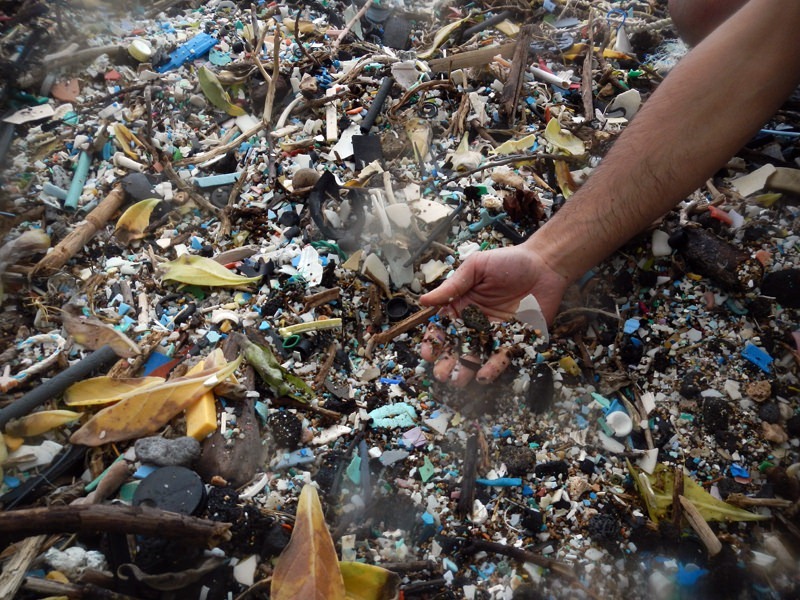On the remote southeastern tip of the Big Island of Hawaii, lies the beach of Kamilo, where swirling ocean currents bring and dump all sorts of trash from the Pacific Northwest. Traditionally, the native Hawaiians would go there to collect large evergreen logs that drifted ashore, from which they fashioned dugout canoes. Today, instead of logs tons of plastic litter the crescent-shaped beach for more than a mile.
Hawaii is situated in the path of the North Pacific Gyre, a large rotating ocean current that circles the Pacific between North America and Japan. The gyre's rotational pattern draws in trash from across the North Pacific Ocean, including coastal waters off North America and Japan, and traps it at the center to form the Great Pacific Garbage Patch. Almost 90% of this trash is plastic.

Photo credit: Algalita.org
Contrary to common belief, the garbage patch is not a floating island of debris visible from satellites or from a boat or plane. Rather, they are like a vast, plastic soup consisting of millions of plastic pieces that have disintegrated into tiny particles under the elements. They remain suspended in the water just below the surface, hidden from view. They only become visible when they get washed ashore, like on the beaches of Hawaii.
The Hawaiian archipelago, which stretches from the Big Island of Hawaii westward for 1,500 miles to Kure Atoll, acts like teeth of a giant comb, collecting debris as it blows by and washing them ashore. A lot of this waste ends up at Kamilo Beach.
In recent years, several community-based cleanup efforts have taken place on Kamilo Beach. Prior to these efforts, the debris was 8 to 10 feet high in some places. Still, volunteers remove between 15 and 20 tons of new trash every year from Kamilo and other beaches that stretch nine miles up the coast.


Photo credit: gabriella levine/Flickr

Photo credit: www.oceandefenderhawaii.com
Sources: Wikipedia / Greenhome.com / LA Times
Hawaii is situated in the path of the North Pacific Gyre, a large rotating ocean current that circles the Pacific between North America and Japan. The gyre's rotational pattern draws in trash from across the North Pacific Ocean, including coastal waters off North America and Japan, and traps it at the center to form the Great Pacific Garbage Patch. Almost 90% of this trash is plastic.

Photo credit: Algalita.org
Contrary to common belief, the garbage patch is not a floating island of debris visible from satellites or from a boat or plane. Rather, they are like a vast, plastic soup consisting of millions of plastic pieces that have disintegrated into tiny particles under the elements. They remain suspended in the water just below the surface, hidden from view. They only become visible when they get washed ashore, like on the beaches of Hawaii.
The Hawaiian archipelago, which stretches from the Big Island of Hawaii westward for 1,500 miles to Kure Atoll, acts like teeth of a giant comb, collecting debris as it blows by and washing them ashore. A lot of this waste ends up at Kamilo Beach.
In recent years, several community-based cleanup efforts have taken place on Kamilo Beach. Prior to these efforts, the debris was 8 to 10 feet high in some places. Still, volunteers remove between 15 and 20 tons of new trash every year from Kamilo and other beaches that stretch nine miles up the coast.


Photo credit: gabriella levine/Flickr

Photo credit: www.oceandefenderhawaii.com
Sources: Wikipedia / Greenhome.com / LA Times
Kamilo Hawaii's Plastic Beach
4/
5
Oleh
Chandu Numerology










